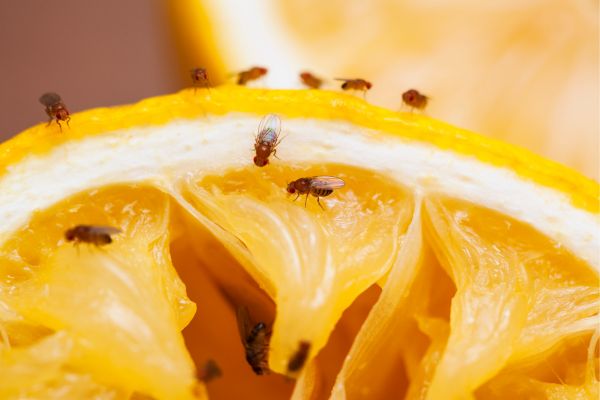Your cart is currently empty!

19 Jun Buzzing Pests Unmasked: Fruit Flies vs. Fungus Gnats
Have you ever noticed tiny, flying insects hovering around your kitchen or indoor plants? It’s easy to mistake them for one another, but there are distinct differences between fruit flies and fungus gnats. Understanding these differences is crucial for effective pest management and finding the right solutions to deal with these pesky intruders. In this article, we will explore the characteristics, habits, and potential risks associated with fruit flies and fungus gnats, helping you identify and address the specific insect issue you may be facing.
Fruit Flies: The Kitchen Intruders
Fruit flies, or Drosophila melanogaster, are small insects that commonly infest kitchens, grocery stores, and other areas where ripe or decaying fruits and vegetables are present. Here’s what you need to know about fruit flies:
1. Appearance: Fruit flies are typically tan or yellowish-brown in colour, measuring about 1/8 inch in length. They have red eyes, a rounded body, and transparent wings.
2. Habitat And Diet: Fruit flies are attracted to overripe fruits, vegetables, and fermenting organic matter. They lay their eggs on these food sources, and the larvae feed on the decaying material.
3. Life Cycle: Fruit flies have a short life cycle, typically completing it in just a week or two. Females lay eggs on moist surfaces near fermenting food, and the larvae emerge within a day. They feed and develop for several days before pupating and transforming into adult flies.
4. Risks: Fruit flies are more of a nuisance than a direct threat to human health. However, they can contaminate food and surfaces with bacteria and other pathogens, making them a potential hygiene concern.
Fungus Gnats: The Plant Pests
Fungus gnats, or Sciaridae, are small flies that are commonly found in indoor plant environments. Here’s what you need to know about fungus gnats:
1. Appearance: Fungus gnats are usually black or dark brown, measuring about 1/8 inch in length. They have slender bodies, long legs, and wings that are often held above their bodies when at rest.
2. Habitat And Diet: Fungus gnats thrive in damp, organic-rich soil and are attracted to the fungus that grows on decomposing plant matter. The larvae feed on fungi and organic material, including plant roots.
3. Life Cycle: Fungus gnats have a life cycle similar to fruit flies. Females lay eggs in moist soil, and the larvae hatch and feed on organic matter for several weeks. They then pupate in the soil before emerging as adult flies.
4. Risks: While fungus gnats are primarily plant pests, their larvae can damage plant roots and impede the uptake of water and nutrients, leading to stunted growth and other plant health issues. However, they do not pose a direct risk to human health.
To differentiate between fruit flies and fungus gnats, consider their appearance, habitat, and behaviours. Fruit flies are more likely to be found in kitchens, near ripe fruits and vegetables, while fungus gnats are commonly spotted around indoor plants and damp soil. Additionally, fruit flies tend to fly in a zigzag pattern and are attracted to sweet odours, while fungus gnats have a more erratic flight pattern and are drawn to damp environments.
Managing Fruit Flies and Fungus Gnats:
If you are dealing with fruit flies, proper sanitation and eliminating potential food sources are key. Keep your kitchen clean, promptly dispose of ripe or decaying fruits and vegetables, and consider using fruit fly traps or homemade vinegar traps to catch and control their population.
For fungus gnat management, focus on addressing the underlying moisture issue. Allow the top layer of soil to dry out between waterings, improve drainage, and avoid overwatering. Sticky traps can be effective in catching adult gnats, while beneficial nematodes or biological controls like NemaKnights Fungus Gnat & Thrips Control can target the larvae in the soil.
Don’t let fungus gnats and thrips take away the beauty and health of your indoor plants any longer. Take action now and invest in NemaKnights Fungus Gnat & Thrips Control. It’s time to regain control and give your plants the protection they deserve.
Visit the Environmental Factor website today and order your NemaKnights solution. Experience the joy of a thriving, pest-free indoor garden and let your plants flourish once again. Together, we can create a greener, healthier environment for you and your cherished green companions.


